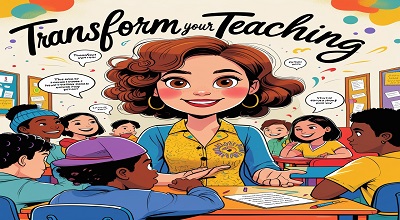Transform Your Teaching
Transform Your Teaching: Improvisation (improv) is no longer just for theater students—it’s a powerful educational tool that fosters creativity, collaboration, and critical thinking in the classroom. Teachers worldwide are adopting improv techniques to enhance student engagement, improve communication skills, and create a dynamic learning environment.
In this comprehensive guide, we’ll explore the latest improv strategies for educators, their benefits, and practical ways to integrate them into your teaching. Whether you’re a seasoned teacher or new to improv, this post will provide actionable insights to transform your classroom.
What is Improv in Education?
Definition and Core Principles
Improv in education involves using unscripted, spontaneous activities to promote learning. Rooted in theater, improv relies on principles like:
- “Yes, And…” – Accepting ideas and building on them.
- Active Listening – Encouraging students to respond thoughtfully.
- Collaboration – Working together to create solutions.
How Improv Differs from Traditional Teaching?
Unlike rigid lesson plans, improv is flexible and student-centered. It shifts the focus from memorization to experiential learning, making lessons more interactive.
The Benefits of Improv in the Classroom
Boosts Confidence and Public Speaking
Improv helps students overcome fear of speaking in front of peers by creating a low-pressure environment.
Enhances Creativity and Problem-Solving
With no “wrong answers,” students learn to think outside the box.
Strengthens Collaboration and Teamwork
Group improv games teach students to work together and respect diverse ideas.
Reduces Anxiety and Encourages Risk-Taking
A playful atmosphere helps students embrace mistakes as part of learning.
Latest Improv Techniques for Teachers
“Yes, And…” for Active Learning
This foundational improv rule teaches students to accept contributions and expand on them, fostering a growth mindset.
Storytelling Games for Language Development
Activities like “One-Word Story” improve vocabulary and narrative skills.
Role-Playing for Empathy and Social Skills
Students act out real-life scenarios to understand different perspectives.
Quick-Thinking Exercises for Critical Thinking
Games like “Word Association” sharpen reflexes and cognitive flexibility.
How to Implement Improv in Different Subjects?
1: Improv in STEM
- Science: Role-play as scientists debating theories.
- Math: Use improv to solve word problems collaboratively.
2: Improv in Language Arts
- Debates: Improv-style arguments strengthen persuasive writing.
- Poetry: Spoken-word improv enhances creative expression.
3: Improv for Special Education
Adapted games help students with autism or ADHD develop social skills in a structured yet fun way.
Success Stories: Teachers Using Improv Effectively
Case Study: A Math Teacher’s Improv Experiment
Mr. Rodriguez introduced improv games to his algebra class, resulting in a 20% increase in participation.
How a History Class Became More Engaging with Improv?
Students reenacted historical events, leading to deeper understanding and retention.
Overcoming Challenges When Using Improv
Dealing with Shy or Reluctant Students
Start with low-pressure activities and gradually increase complexity.
Managing Classroom Dynamics
Set clear rules to ensure respectful interactions.
Assessing Learning Outcomes
Use rubrics to evaluate participation, creativity, and collaboration.
Resources and Tools for Improv in Education
- Books: “Teaching Improv” by Mel Paradis
- Online Courses: Coursera’s “Improv for Educators”
- Free Games: ImprovEncyclopedia.org
Future of Improv in Education
With virtual reality and AI, improv can become even more immersive, helping students practice real-world skills in simulated environments.
FAQs About Improv in the Classroom
1. Can improv work in online classrooms?
Yes! Virtual improv games like “Zoom Charades” keep remote students engaged.
2. Do I need acting experience to use improv?
No—basic improv games are easy to learn and require no prior training.
3. How do I assess improv activities?
Focus on participation, creativity, and teamwork rather than right/wrong answers.
4. What age group benefits most from improv?
All ages! Adapt games for elementary to high school students.
5. Can improv help with classroom management?
Yes—it builds trust and communication, reducing behavioral issues.
Conclusion
Improv is a transformative tool that makes learning fun, interactive, and impactful. By integrating the latest improv strategies, teachers can foster a classroom environment where students thrive academically and socially.
